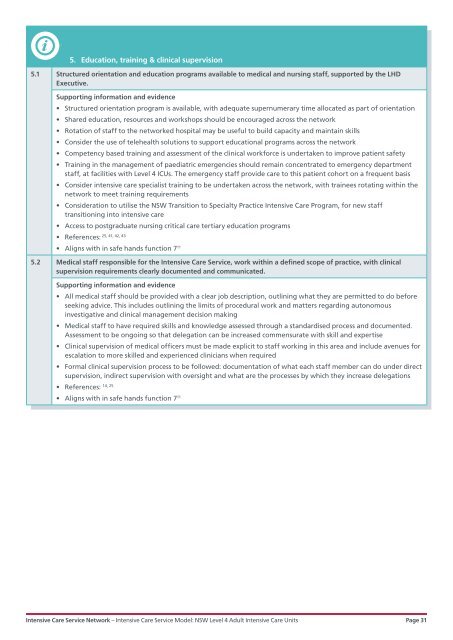Intensive Care Service Model NSW Level 4 Adult Intensive Care Units
1Olm7HQ
1Olm7HQ
You also want an ePaper? Increase the reach of your titles
YUMPU automatically turns print PDFs into web optimized ePapers that Google loves.
5. Education, training & clinical supervision<br />
5.1 Structured orientation and education programs available to medical and nursing staff, supported by the LHD<br />
Executive.<br />
Supporting information and evidence<br />
• Structured orientation program is available, with adequate supernumerary time allocated as part of orientation<br />
• Shared education, resources and workshops should be encouraged across the network<br />
• Rotation of staff to the networked hospital may be useful to build capacity and maintain skills<br />
• Consider the use of telehealth solutions to support educational programs across the network<br />
• Competency based training and assessment of the clinical workforce is undertaken to improve patient safety<br />
• Training in the management of paediatric emergencies should remain concentrated to emergency department<br />
staff, at facilities with <strong>Level</strong> 4 ICUs. The emergency staff provide care to this patient cohort on a frequent basis<br />
• Consider intensive care specialist training to be undertaken across the network, with trainees rotating within the<br />
network to meet training requirements<br />
• Consideration to utilise the <strong>NSW</strong> Transition to Specialty Practice <strong>Intensive</strong> <strong>Care</strong> Program, for new staff<br />
transitioning into intensive care<br />
• Access to postgraduate nursing critical care tertiary education programs<br />
25, 41, 42, 43<br />
• References:<br />
• Aligns with in safe hands function 7 11<br />
5.2 Medical staff responsible for the <strong>Intensive</strong> <strong>Care</strong> <strong>Service</strong>, work within a defined scope of practice, with clinical<br />
supervision requirements clearly documented and communicated.<br />
Supporting information and evidence<br />
• All medical staff should be provided with a clear job description, outlining what they are permitted to do before<br />
seeking advice. This includes outlining the limits of procedural work and matters regarding autonomous<br />
investigative and clinical management decision making<br />
• Medical staff to have required skills and knowledge assessed through a standardised process and documented.<br />
Assessment to be ongoing so that delegation can be increased commensurate with skill and expertise<br />
• Clinical supervision of medical officers must be made explicit to staff working in this area and include avenues for<br />
escalation to more skilled and experienced clinicians when required<br />
• Formal clinical supervision process to be followed: documentation of what each staff member can do under direct<br />
supervision, indirect supervision with oversight and what are the processes by which they increase delegations<br />
14, 25<br />
• References:<br />
• Aligns with in safe hands function 7 11<br />
<strong>Intensive</strong> <strong>Care</strong> <strong>Service</strong> Network – <strong>Intensive</strong> <strong>Care</strong> <strong>Service</strong> <strong>Model</strong>: <strong>NSW</strong> <strong>Level</strong> 4 <strong>Adult</strong> <strong>Intensive</strong> <strong>Care</strong> <strong>Units</strong> Page 31


